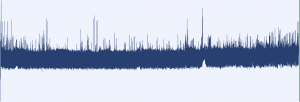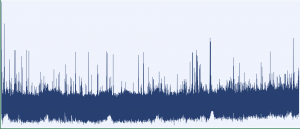Relationship between sound level in dorm and sleep quality
Shijie Guo
Project Description:
My project was aimed to find out the relationship between noise level in the dorm overnight and my sleeping patter and sleeping quality. The level of sound in the dorm over night was found by using the app “Decibel 10th” on my iPhone. To find my sleeping patterns, I used LabQuest’s x-acceleration, y-acceleration, and z-acceleration sensor. I put the LabQuest under my pillow to record my movement while I was asleep. Then I used Logger Pro and Excel to graph x, y, and z acceleration and sound level. By comparing the graphs, I can conclude if there is any correlation between sound level and my sleeping pattern.
Results:
February 21st:
Figure 1 Sound Level on February 21
Figure 2 Sleeping Pattern Feb 21
February 23rd:
Figure 3 Sound Level Feb 23
Figure 4 Sleeping Pattern Feb 23
March 8:
Figure 5 Sound Level March 8
Figure 6 Sleeping Pattern March 8
Interpretation of the results:
As shown above in the figures, when there is an abrupt change in the x, y, or z acceleration, there is also an increase in sound level. However, when there is an abrupt change in the sound level, it’s not necessary to have a change in x, y, or z acceleration. So, we can conclude that might be some correlation between sound level and sleeping pattern. However, it’s insufficient to conclude that there is a causation relationship between the two.
Results vs. Predicted:
My predicted result was that there would be strong evident to show change in sound level could cause change in sleeping pattern. However, the results suggest that there is no causation. Noise level in dorm could a contributing factor to sleeping factor, but it’s not enough to cause change in sleeping patterns alone.
Science learned:
Before doing this project, I don’t know how applications on smart phones are able to measure people’s sleeping quality. After this project, I learned that we can measure people’s sleeping pattern by measuring their movement while they are asleep (by measuring acceleration on x, y, and z directions).
What I’d do differently:
If I were to this project again, I would use apps on iPhone to measure my sleeping quality because it’s easier to visualize data on apps than on LabQuest. And putting LabQuest, a thick block object, under my pillow may affect my sleeping and thus affecting the result. And I would use a sound meter that can be programed to collect data at certain intervals. What I did was to keep sound meter running for 8 hours and, as a result, the size of data was overwhelming even for computer to graph and analyze. If I could reduce the size of data while keep the effectiveness of data, it would be better.
If I had to continue this project for another 6 weeks:
If this project were to be continued for another 6 weeks, I would measure my sleeping pattern without any influence from noise in the room (perhaps by sleeping in a quiet hotel over Spring Break). And I can use this uninfluenced sleeping pattern data as background data and compare it with my sleeping pattern when I was affected by noise in the room. So, I can conclude how much influence does the change in noise level have on my sleeping pattern.





